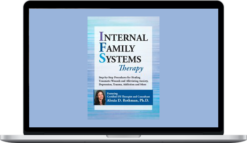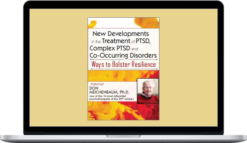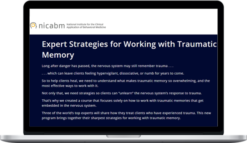NICABM – Rethinking Trauma
$397.00 $97.00
Total Sold: 2
»Instant Delivery
Description
NICABM – Rethinking Trauma
Description of Rethinking Trauma
In just this past year alone, experts have discovered new methods for working with trauma’s pernicious symptoms. Their work alone and collectively has provided us with so much more than we knew . . .
. . . only a year ago.
Even as recently as five years ago, we didn’t understand that the lower brain could command the shutdown response, totally bypassing the prefrontal cortex, totally bypassing any sense of “choice.” And we didn’t understand how important the role of neuroception was to the process of feeling safe.
Or how we might calm the fear in a traumatized brain using neurofeedback.
Your patients’ nervous system may be making decisions without their “permission.”
But now we have many more options to help our patients. Especially when we use what we now know about how trauma impacts the nervous system and the brain.
With the right adjustments, techniques that once fell flat can be honed to work more effectively with the symptoms of unresolved trauma.
Understanding the brain’s role can bring depth and power to our interventions.
It allows us to resource our patients with skills to stabilize, ground, and short-circuit old patterns of reactivity. Then we’re better able to clear a way for the deeper work of healing.
Using what we are now learning can help our patients experience fewer symptoms, get better sleep, become more self-reflective and feel more confident.
It all begins in the body – especially the brain.
There’s nothing like the confidence, energy, and deep satisfaction of seeing clients make progress.
Imagine your client pausing in a moment of reactivity and calling on the repertoire of skills you taught them for self-soothing, developing greater stability and resilience – not just in your office, but during the rest of their week as well.
Imagine them feeling safe, with a sense of agency and even self-esteem.
When our interventions succeed, it’s a huge boost to confidence – not just for us, but for our clients, too.
As a practitioner, it’s hard to beat the gratification of seeing a client’s life opening back up.
We feel less burnt out and drained, and feel the joy of the profoundly rewarding work we do.
New techniques, like limbic system therapy, neurofeedback, and other brain and body-oriented approaches…
…that include a polyvagal perspective could be the key to providing more targeted treatments to help trauma patients manage dissociation, reactivity, and instability.
That’s why the best practitioners invest in their professional development.
We’ve put together a new webinar series to bring you leading-edge methods for treating trauma straight from the pioneers in the field.
In Rethinking Trauma, we’ll zero in on big picture developments as well as the details of specific techniques that you can take back to your office.
What you’ll learn in Rethinking Trauma
- Downloadable videos and audios to watch or listen to when it’s convenient for you
- Check mark TalkBack Segments to distill key ideas (this is where we “land” the session)
- Check mark Next Week in Your Practice sessions to give you concrete strategies to use with patients
- Check mark Printable QuickStart Guides to make review and action simpler than ever
- Check mark Professionally-formatted transcripts of the sessions
- Check mark Audios and transcripts of the bonus sessions
More courses from the same author: NICABM
Proof:
Delivery Policy
When will I receive my course?
You will receive a link to download your course immediately or within 1 to 21 days. It depends on the product you buy, so please read the short description of the product carefully before making a purchase.
How is my course delivered?
We share courses through Google Drive, so once your order is complete, you'll receive an invitation to view the course in your email.
To avoid any delay in delivery, please provide a Google mail and enter your email address correctly in the Checkout Page.
In case you submit a wrong email address, please contact us to resend the course to the correct email.
How do I check status of my order?
Please log in to HealingCourse account then go to Order Page. You will find all your orders includes number, date, status and total price.
If the status is Processing: Your course is being uploaded. Please be patient and wait for us to complete your order. If your order has multiple courses and one of them has not been updated with the download link, the status of the order is also Processing.
If the status is Completed: Your course is ready for immediate download. Click "VIEW" to view details and download the course.
Where can I find my course?
Once your order is complete, a link to download the course will automatically be sent to your email.
You can also get the download link by logging into your HealingCourse account then going to Downloads Page.
Related products
Total sold: 1









